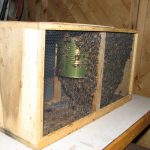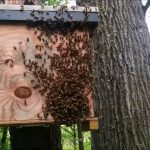Easy use of Frames
Our swarm trap accommodates both wood and plastic medium frames. Once the bees settle, none of their work is lost allowing beekeepers to check at their leisure.
Easy to Set Up
Hand tighten 4 nuts and bolts. Use a cotton swab to wipe the liquid lure onto the entrance. Then simply hang from a tree in your own backyard.
(Save precautions for when you catch the bees.)
Easy to Transfer
Wearing protective clothing, allow the bees to acclimate to their new hive location and simply remove the bolts and (carefully) place each medium frame into the new hive.
(More info here.)
So what are you waiting for?
Once stocked, The refuBees Swarm Trap is a simple click away! Not only do we appreciate your business, but local bees and beekeepers thank you too.
Problem Worth Solving
Honeybees, and other pollinators, are essential to agriculture in the US. Beekeepers are experiencing increased losses of colonies, particularly after the winter months.
With honeybees dying and/or absconding, beekeepers need to maintain full hives to market and sell their honey, wax, etc. Currently they have three options, buy packages of bees, use current swarm traps on the market, or retrofit old hive boxes and hope they can lure bees into it.
Current Alternatives
With bee colonies vanishing or dying, what are beekeepers choices to replenish population’s numbers both from a business and environmental standpoint?

Bee Packages
The first is expensive and most common, packages of bees steadily approaching $200 for the 2018 spring season and the quality/lineage of the honeybees is uncertain. The bees bought in packages are usually from commercial apiaries, and supplementing the hives with sugar water and/or pollen cakes is mandatory.

"Flower Pot" Style Traps
The second is cheaper than the first, but has its drawbacks. Should bees settle into the swarm trap, any work done in the time until the time the beekeeper removes the trap is lost. On top of that, the traps don’t stand up to prolonged exposure to inclement weather and are generally only intended for a single use.

Retrofitted Hives
The third option takes time, requiring manual labor to retrofit an existing hive to be smaller and more manageable. The wood can be heavy, not to mention hives are expensive, so it’s in a beekeeper’s best interests to repair a hive for a colony, not saw it down for a trap.

